Different species of the same type of animal can vary widely. They may have different coloring, marking, behavior, and sizes. There are over 40 types of deer in the world, encompassing all animals in the Cervidae family. Old-World deer include Asian deer species, while New World deer include those in North and South America. So, what are the different sizes of each deer species and how big do they actually get?
1. White Tail Deer
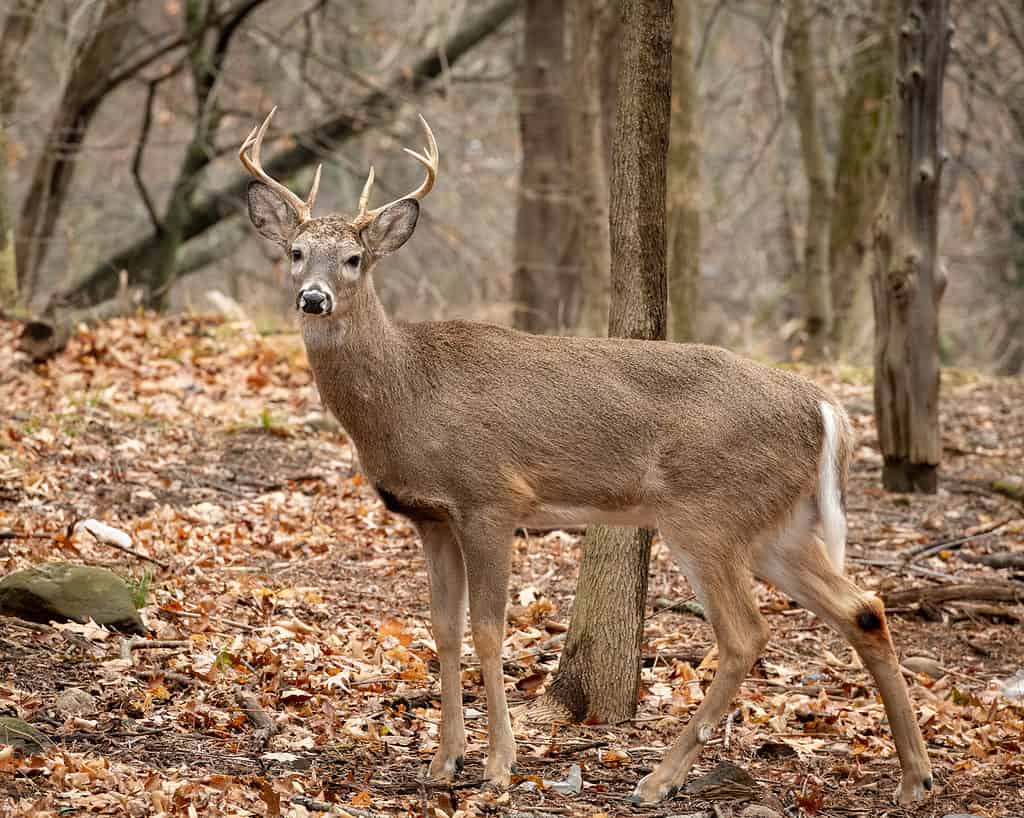
Only male white-tailed deer like this one have antlers.
©Herbie Pabst/Shutterstock.com
Other Names: Virginia Deer
Range: North, Central, and South America from Southern Canada to Peru
Size: Male white tails can grow up to 300 pounds, though one as large as 500 pounds has been found in Northern Canada. Females are smaller than males, weighing up to 200 pounds. They can be more than 7 feet long, 3.9 feet high, and can have a tail longer than 14 inches. Their antlers can be up to 20 inches long and 20 inches wide. Only males have antlers.
How it Compares: White-tailed deer are the most common deer species in North America. They are slightly larger than the next most common species, the black-tail deer and mule deer. On average, they are just about 1/5 the size of a moose.
A white-tailed deer can weigh twice as much as the average human. Though they are a bit shorter at shoulder height, they may be as high as a human with neck, head, and antlers accounted for.
Though they are about half the length of the average car and less than 10% of the weight of an average car, they can still cause a lot of damage during car accidents.
2. Black Tail Deer
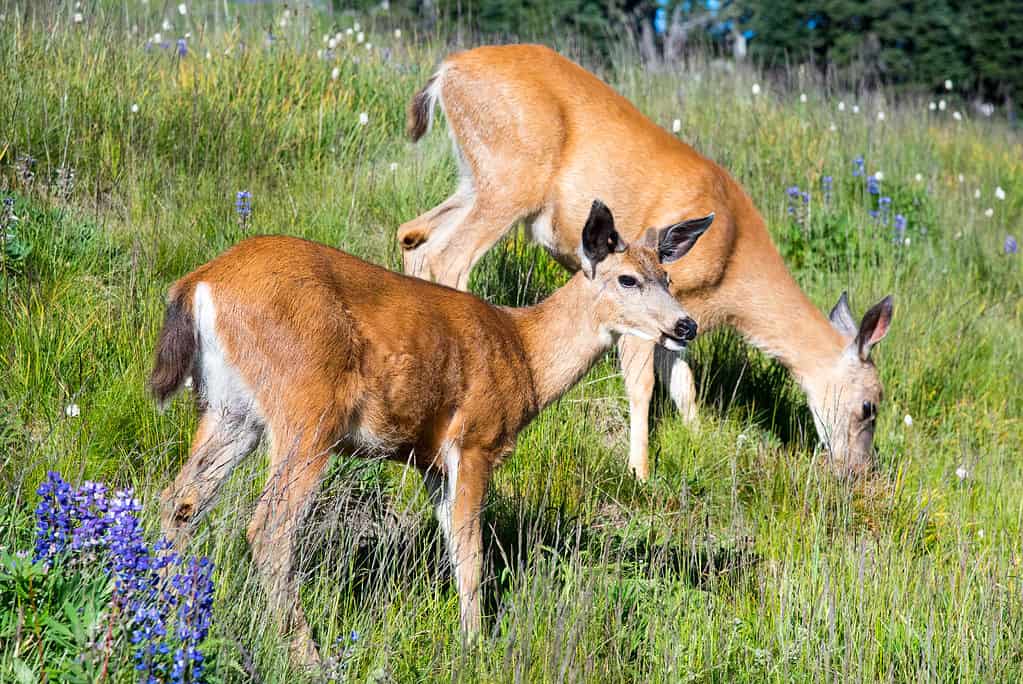
Female black tail deer do not have antlers.
©SteelPhotography/Shutterstock.com
Other Names: Black-Tailed Deer
Range: The west coast of North America from Northern California to Southern Alaska
Size: These deer weigh up to 225 pounds. They are up to 5 and a half feet long and up to 3.7 feet tall. Their antlers can grow more than 18 inches tall. Females do not have antlers.
How it Compares: Black-tail deer are slightly smaller than white-tail deer. They are around the same size as mule deer. They weigh more than 17 times the weight of the smallest deer species, the northern pudu.
Black-tailed deer weigh as much as some people. However, most humans will be a bit taller than this species of deer.
They are about the same length as a petite loveseat sofa.
3. Red Deer
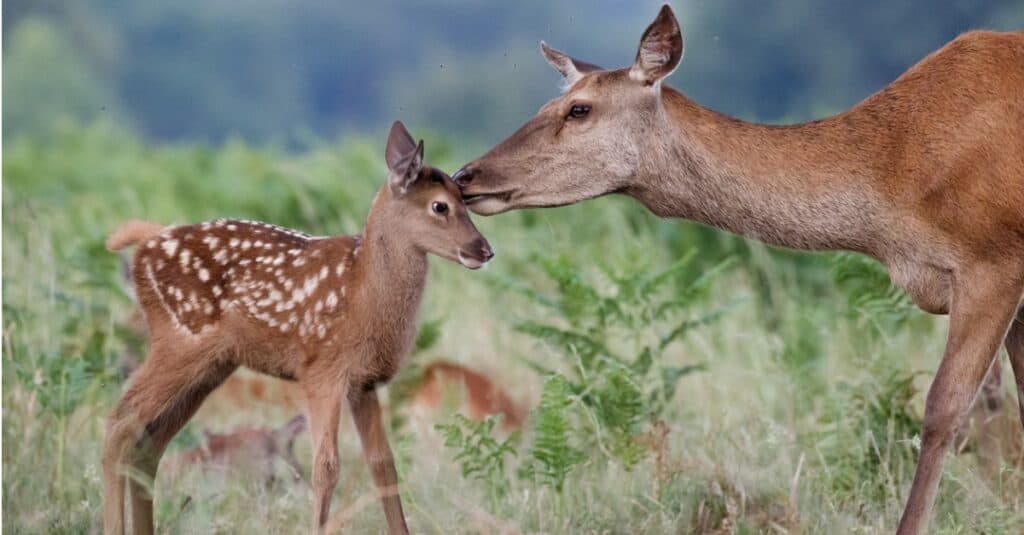
This mother red deer is giving her fawn a bath.
©shaftinaction/Shutterstock.com
Range: Europe, Western Asia, Northern Africa
Size: A male red deer can be over 8 feet long and weigh up to 530 pounds. However, the Corsican red deer subspecies can grow up to 1,100 pounds. A female can grow to more than 6.5 feet long and weigh up to 370 pounds. Their tails are up to 7.5 inches long. Their shoulder height is over four feet on average. Their antlers, which are only present on males, can weigh up to 2.2 pounds and are up to 28 inches long.
How it Compares to Other Deer Species: Red deer are one of the larger deer species. The only larger species are moose and elk. They are about 1/8 the weight of a car and are much taller and longer than the average person. Although deer are often peaceful, humans should always be careful when dealing with animals this large.
4. Mule Deer
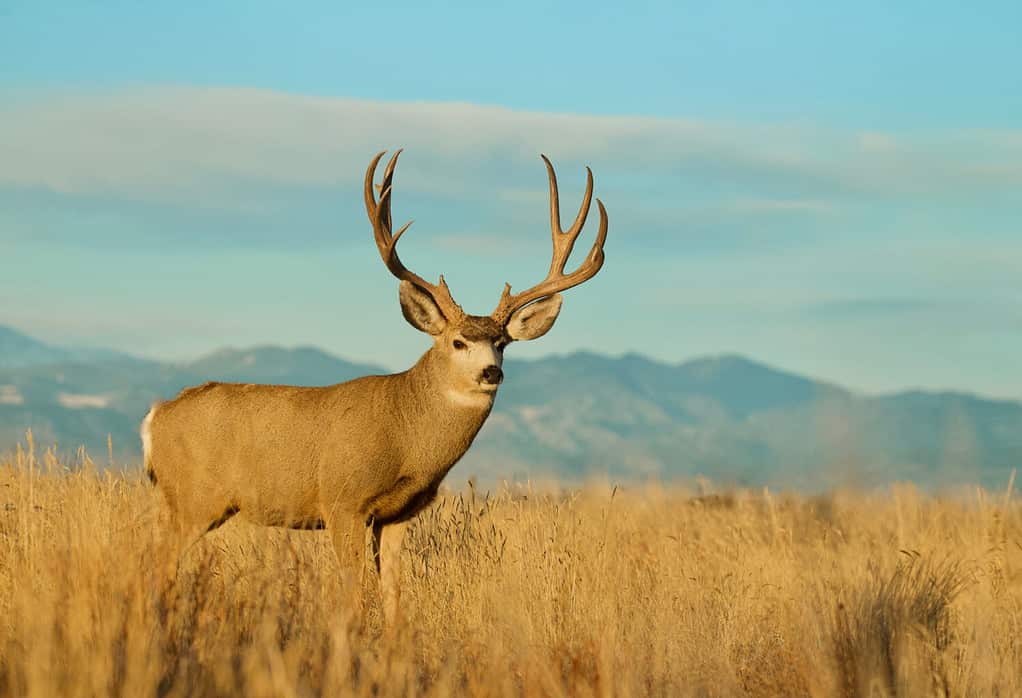
Mule deer are native to the American West, Canada, and Mexico.
©Tom Reichner/Shutterstock.com
Range: Western North America from Southern Canada into Mexico
Size: Mule deer are up to 6.9 feet long and can weigh as much as 460 pounds, though their average weight is more like 230 pounds. As with most deer species, females are smaller. They weigh up to 200 pounds but are more like 150 pounds on average. Their antlers can be up to 26 inches wide. Only males have antlers.
How it Compares: Mule deer are about the same size as black-tailed deer. They are over twice as big as the chital deer species. Their antlers alone are about the width of a four or five-month-old human baby.
5. Chital
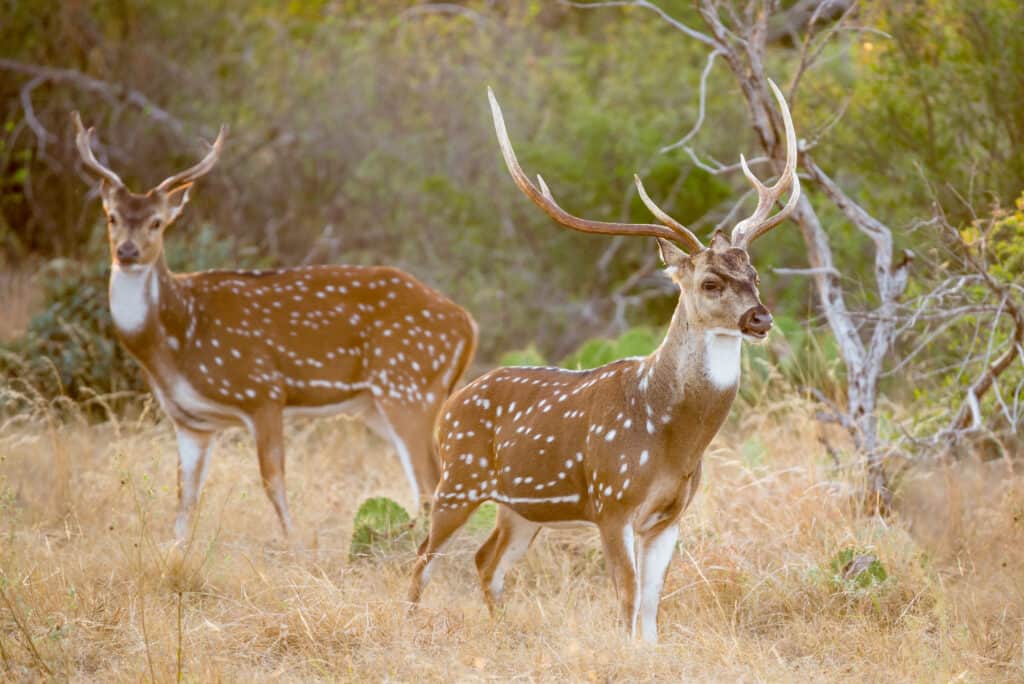
The chital is one of the only deer species that does not lose its spots as they become adults.
©GizmoPhoto/Shutterstock.com
Other Names: Axis Deer, Cheetal Deer, Spotted Deer
Range: South Asia, including much of India, parts of Nepal, Bhutan, Bangladesh, and Sri Lanka
Size: Chital are less than 3 feet tall at the shoulder. Males can weigh up to 200 pounds, and females weigh up to 130 pounds. Their bodies are up to 5 feet long and their tails are up to 10 inches long. Their antlers, only seen on males, are an astonishing 3 feet and 3 inches long.
How it Compares: Fallow deer and chital are around the same height, though they weigh much less. Chital have much larger antlers than fallow deer.
A chital would be a bit shorter than the average human and weighs about as much as many people. However, their large antlers may set them apart and make them appear taller, and more intimidating.
A chital is around the same length as a park bench.
7. Reindeer

Both male and female
reindeer
have antlers.
©iStock.com/Artpilot
Other Names: Caribou
Range: Northern Europe, Siberia, Northern North America
Size: Reindeer weigh up to 550 pounds. They are up to 4.9 feet tall at shoulder height and measure up to 7 feet long. Their antlers can grow up to 51 inches long on a male, and up to 20 inches on a female.
How it Compares: Reindeer are roughly the same size as Thorold’s deer. They also weigh about as much as some red deer but are smaller in other dimensions. Either way, Reindeer are one of the larger deer species. However, they are only about 1/3 the weight of a moose.
Compared to a person, a male reindeer is usually larger, but a female one is about the same height. Their length is about the same as a king-size mattress.
8. Elk
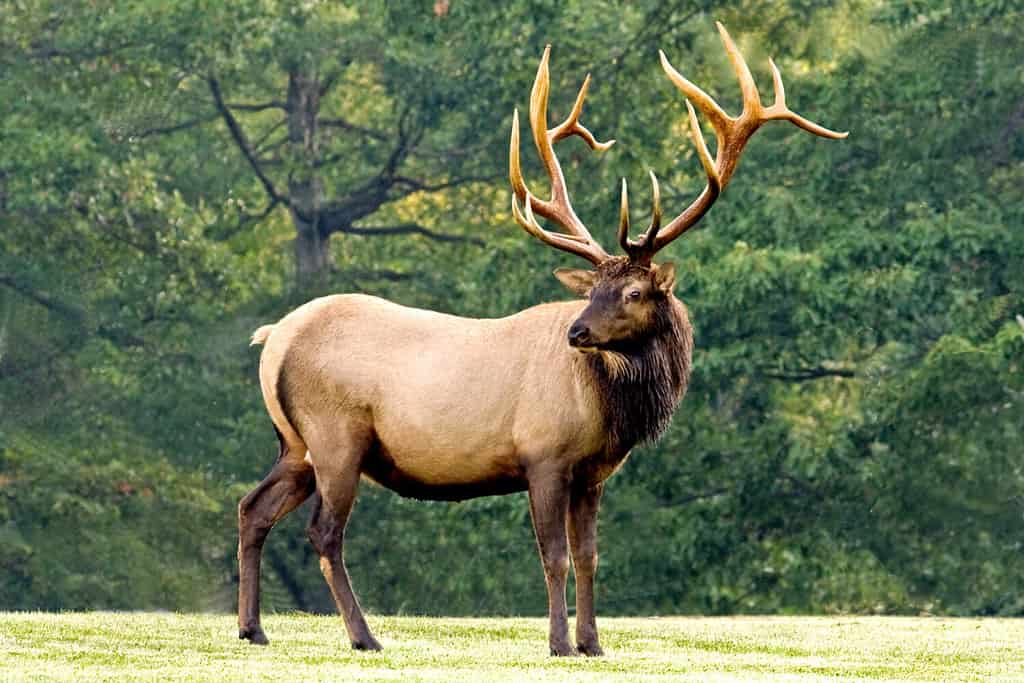
Elk antlers are massive and can grow up to 4 feet long.
©Paul Staniszewski/Shutterstock.com
Other Names: Wapiti
Range: Central and East Asia, Siberia, much of the United States, and Southern Canada
Size: Elk are up to 4 feet tall at the shoulder and nearly 9 feet long from tip to tail. Males weigh up to 1100 pounds and females are up to 650 pounds. Their antlers can grow up to 1 inch per day in the growing season. Their antlers alone can account for up to 20 pounds of their weight and can reach up to 4 feet long. Only male elks have antlers.
How it Compares: The elk is the second largest deer species after moose. They weigh 84 times more than the smallest deer species, the northern pudu. They are more than twice as long as the sika deer.
Compared to a human, elk are much larger. They may weigh as much as eight times more than the average person. No human is as tall as an elk is long. An elk is even larger than the average horse. It would take about five mule deer to weigh as much as an elk.
9. Tufted Deer

The tufted deer has hair on top of its head that is usually longer than its antlers.
©Kacper Fijalkowski/Shutterstock.com
Range: Central China and Northeastern Myanmar
Size: Their shoulder height is up to 2.3 feet. They weigh up to 66 pounds. They do have small antlers, but their antlers are usually hidden by their tufts of hair, which can be up to 6.7 inches long. Their tails are less than 4 inches long.
How it Compares: The tufted deer is much smaller than many deer species. They weigh slightly less than a roe deer. They are about the same weight as a standard poodle or retriever breed dog.
In terms of humans, a tufted deer weighs as much as a large eight-year-old or a small 12-year-old. Most adults would be much larger than a tufted deer.
Most people would be taller than a tufted deer, even with their head and small antlers added on to their shoulder height. Their shoulder height is about the same as the height of a coffee table or desk lamp.
11. Fallow Deer
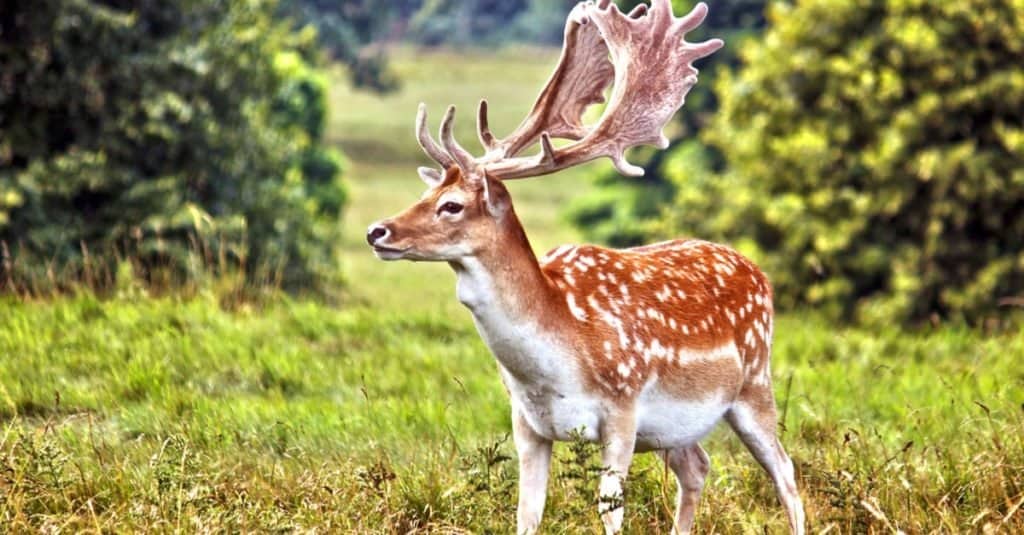
Male fallow deer are typically around 220 pounds.
©Neil Clarke/Shutterstock.com
Other Names: European Fallow Deer, Persian Fallow Deer
Range: European fallow deer live in Europe. Persian fallow deer live in Iran and Israel. While some consider the two to be separate species, others consider the Persian fallow deer to be a subspecies of the European fallow deer.
Size: Fallow deer can grow up to 5 feet long and 3 feet tall at the shoulder. They can weigh up to 330 pounds, but typically weigh more like 220 pounds. Their antlers can grow to over 1 foot.
How it Compares: The height of a fallow deer is the same as a Javan rusa’s antlers alone. They are the same length as a red brocket.
Fallow deer often weigh more than people, but not by much. They are probably about the same size as some people in multiple dimensions.
They weigh about the same as a giant panda or two times the average weight of a beer keg.
12. Moose

Moose are the largest deer species.
©ArtBBNV/Shutterstock.com
Other Names: Moose are called elk in Eurasia, but they shouldn’t be confused with the other deer species known as elk in North America.
Range: The Northern U.S. from Maine to Washington State and Alaska, much of Canada, northern Asia and Europe
Size: Moose antlers can grow over 6 feet wide and may weigh up to 80 pounds. Moose are nearly 7 feet tall at the shoulder. They can weigh up to 1500 pounds and are often more than 10 feet long. In 2004, one moose was killed that weighed over 2200 pounds. Their tails, which experts consider vestigial, are only up to 4 inches long. Moose antlers match their large size: they can be up to 6 feet long.
How it Compares: Moose are the largest deer species. However, they have one of the smallest tails! They weigh 83 times more than the southern pudu, the second smallest deer species. Their antlers are 2 feet larger than elk antlers, and they are twice as long as many deer species including the roe deer and the fallow deer.
Moose are multitudes bigger than most people. Perhaps that is why encountering a moose in the wild can be so scary. They weigh eight times more than the average man. Their antlers alone can weigh as much as a 10-year-old child. The tallest moose are taller than the tallest NBA players. They are taller and heavier than both horses and elk.
One of the only animals heavier than a moose is a bison. Another is an elephant. One thing is clear – you don’t want to get in the way of a moose!
13. Roe Deer

Roe are a smaller deer species weighing up to 75 pounds.
©WildMedia/Shutterstock.com
Other Names: Roe, Western Roe Deer, European Roe Deer
Range: Most of Europe, except Ireland, the northern sections of Finland, Sweden, and Norway
Size: These deer are up to 4.5 feet long and are only 2 feet high at the shoulder. They weigh up to 75 pounds on average. Their antlers are up to 10 inches long.
How it Compares: Roe deer are a light and smallish species. They have antlers the same size as the visayan deer. They weigh slightly more than the tufted deer. Despite their small size they still weigh more than five times as much as the smallest deer, the norther pudu.
The roe deer is smaller than most people. Even their length is smaller than many people are tall. They weigh about as much as a 10-year-old child.
Their length is just over the height of an official NHL hockey net.
14. Sika Deer
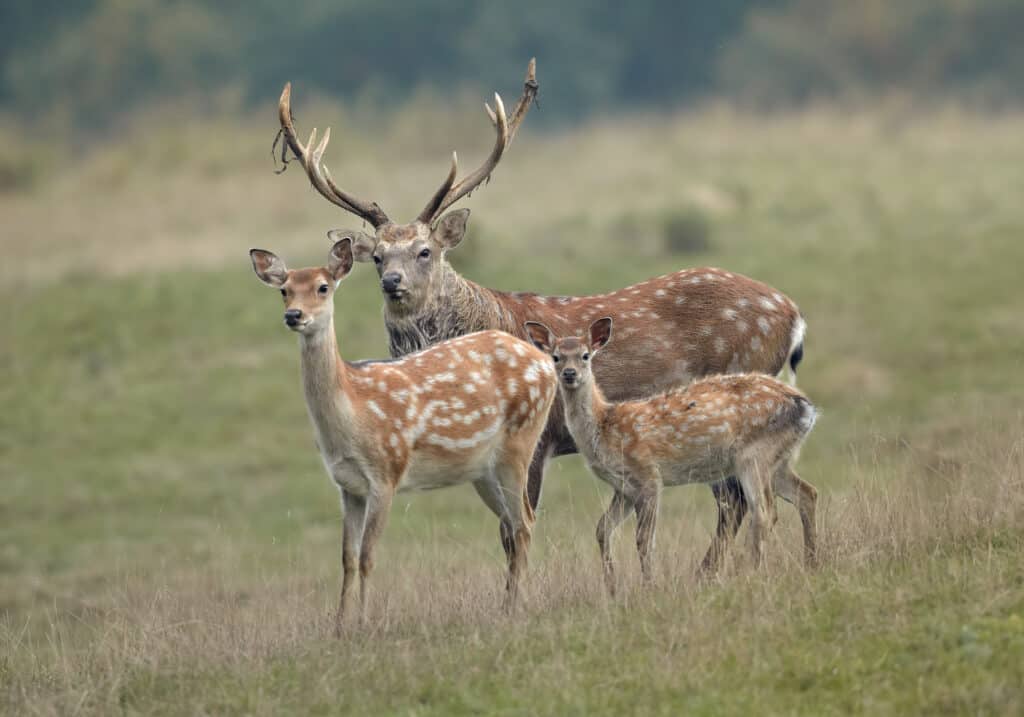
The sika deer is primarily found in Japan.
©Martin Mecnarowski/Shutterstock.com
Other Names: Northern Spotted Deer, Japanese Deer
Range: Mainly Japan
Size: Sika deer can grow up to 240 pounds, with some subspecies weighing up to 440 pounds. However, they are usually more like 90 pounds, with females weighing slightly less. Their antlers can be up to 30 inches long.
16. Sambar Deer
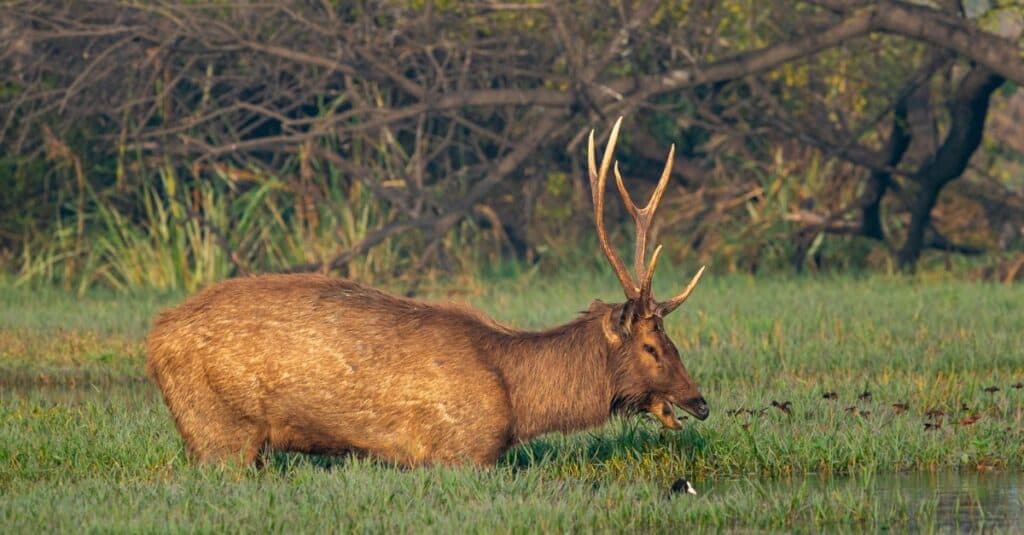
Sambar deer are hefty, with the largest ones weighing in at 1,200 pounds.
©iStock.com/Sourabh Bharti
Range: South Asia including India, Sri Lanka, Bangladesh, Borneo, Sumatra, Southern China, Taiwan
Size: The sambar deer, which is endangered, is around 5 feet tall at the shoulder and weigh up to 1200 pounds. Their tails are long as far as deer go and can measure more than 13 inches. The antlers can grow up to 42 inches long.
How it Compares: The sambar deer weighs more than an elk although they are smaller in stature. They may have the longest tails of any of the deer species mentioned here. Even though they weigh a whopping 1200 pounds, they still weigh 300 pounds less than the average moose.
They weigh as much as 6 or more people, and even their antlers are the height of a four- to six-year-old child.
They are about as high as a treadmill is long.
17. Water Deer
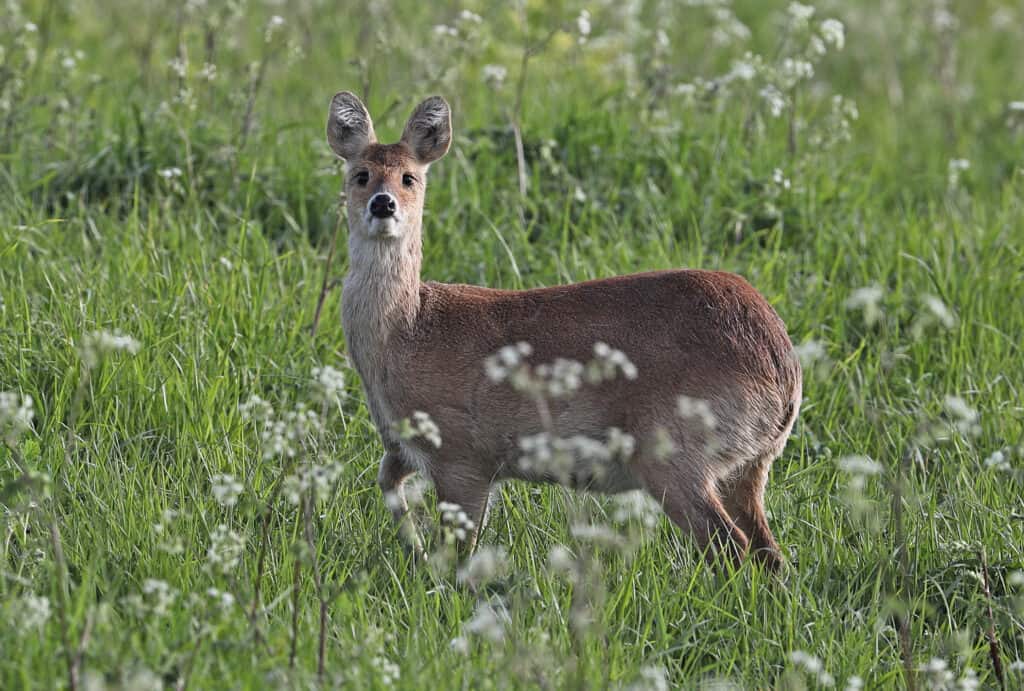
Water deer lack antlers.
©iStock.com/Neil Bowman
Other Names: Vampire Deer
Range: Eastern China and North and South Korea
Size: These small deer weigh up to 33 pounds. They are just over 3 feet long on average and about 2 feet high at the shoulder. Their tails are only 3 inches long. Neither sex of this species has antlers.
How it Compares: The water deer weighs about half as much as the tufted deer, though they are not that much shorter. They weigh about twice as much as the smallest deer species, the northern pudu.
Most adult humans would be quite a lot bigger than the water deer. They weigh about as much as a two or three-year-old child. They are as long as a baseball bat or a guitar.
18. Barasingha

Barasingha antlers can measure up to 30 inches long.
©Sunil lodhwal/Shutterstock.com
Other Names: Swamp Deer, Dolhorina
Range: India
Size: The barasingha is about 4 feet high at the shoulder and 6 feet long. They can weigh up to 620 pounds. Their antlers are around 30 inches long on average.
How it Compares: The barasingha weighs a little less than half as much as an elk. It is about 60% as long as the largest moose.
This larger deer species is much bigger than most people. They weigh as much as about three average-sized humans. With their neck, head, and antlers, their height would probably be more than most people. However, some exceptionally tall people may be taller than a smaller barasingha.
A barasingha is about the same size as a vending machine.
19. Southern Red Muntjac
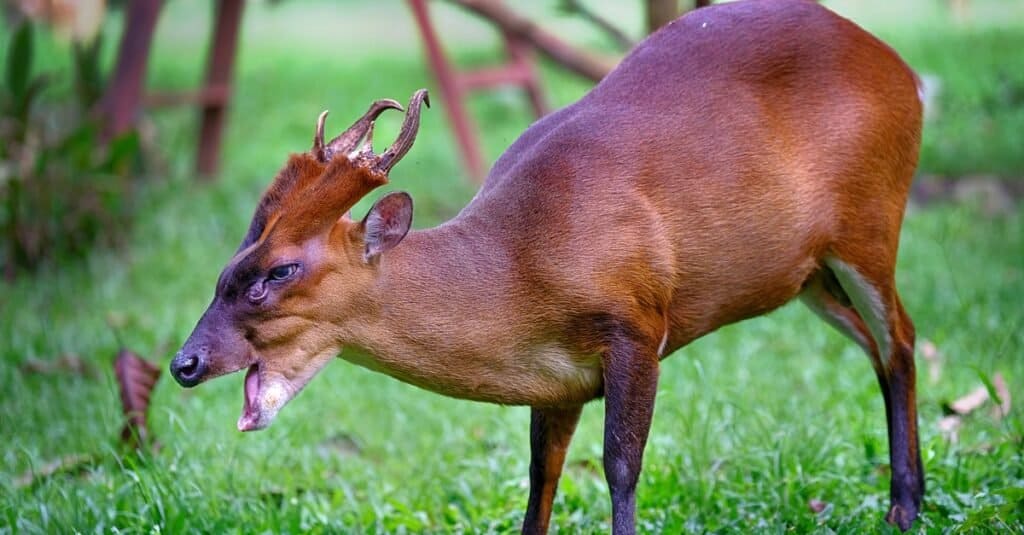
The southern red muntjac gets its name from its reddish color.
©PLOO Galary/Shutterstock.com
Other Names: Indian Muntjac, Common Muntjac, Barking Deer
Range: South Asia including India, Malaysia, Thailand, Myanmar, Sumatra, Java, Bali, and Borneo
Size: Males of this species have antlers that are only 3.9 inches long. Their bodies are about 4.5 feet long, and they are around 2 feet high at the shoulder. They weigh up to 77 pounds. Despite their small size, their tails can be up to 9 inches long.
How it Compares to Other Deer Species: This petite deer species is around the same size as a tufted deer and roe deer, and twice as large as a water deer. They are about 2/5 as long as a moose.
A southern red muntjac weighs about as much as a 10-year-old child and overall, they are smaller than most adult humans. Their antlers are about the same size as a credit card or a popsicle stick.
20. Northern Pudu
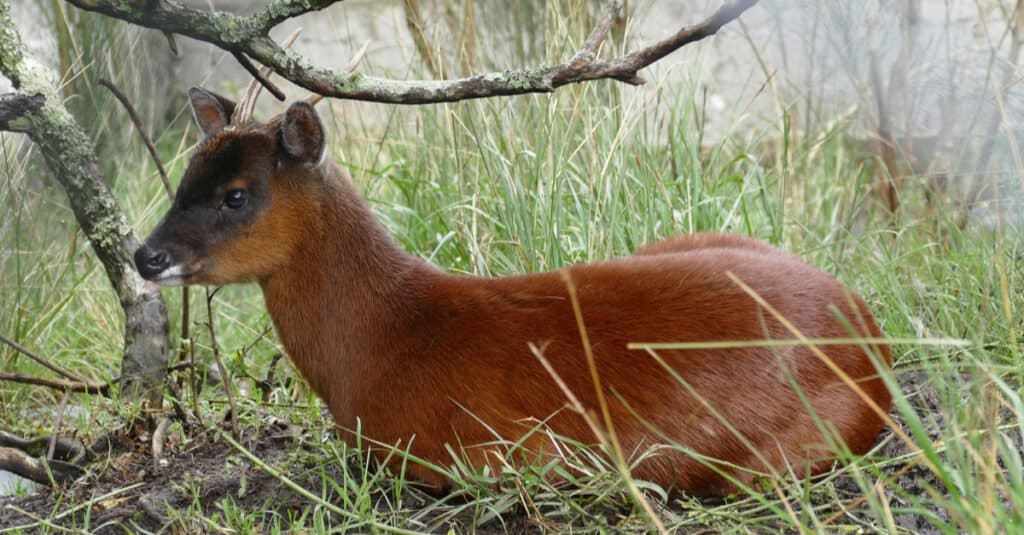
The northern pudu is the smallest deer in the world.
©Helge Zabka/Shutterstock.com
Range: The Andes Mountains in Colombia, Venezuela, Peru, and Ecuador.
Size: While most deer measurements are taken in feet, the northern pudu is measured in mere inches. They come up to about 14 inches at the shoulder and weigh just around 13 pounds. They are about 2.5 feet long and have antlers of less than 3 inches long.
How it Compares: This is the smallest deer species in the world. It is less than 1% of the weight of a moose. They are smaller than most humans, including most children and even many babies! They weigh about as much as a bowling ball, a gallon of paint, or a large house cat.
21. Red Brocket

The red brocket is one of the smallest deer species.
©klarion/Shutterstock.com
Range: South America: Colombia to Northern Argentina.
Size: The red brocket is 31 inches high at the shoulder and nearly 5 feet long. They weigh up to 100 pounds. Their antlers are only around 5 inches long.
How it Compares: Although it is a small deer species, the red brocket is still twice as large as the northern pudu in height. It weighs more than seven times as much as the smallest species. Although they weigh less than both species, they are the same length as both the chital and fallow deer.
A red brocket is the same weight as a small human or an older child. In terms of height, they are shorter than most adults. They weigh just about 1/10 the amount of a common horse and their antlers are about the length of a smartphone.
22. Thorold’s Deer
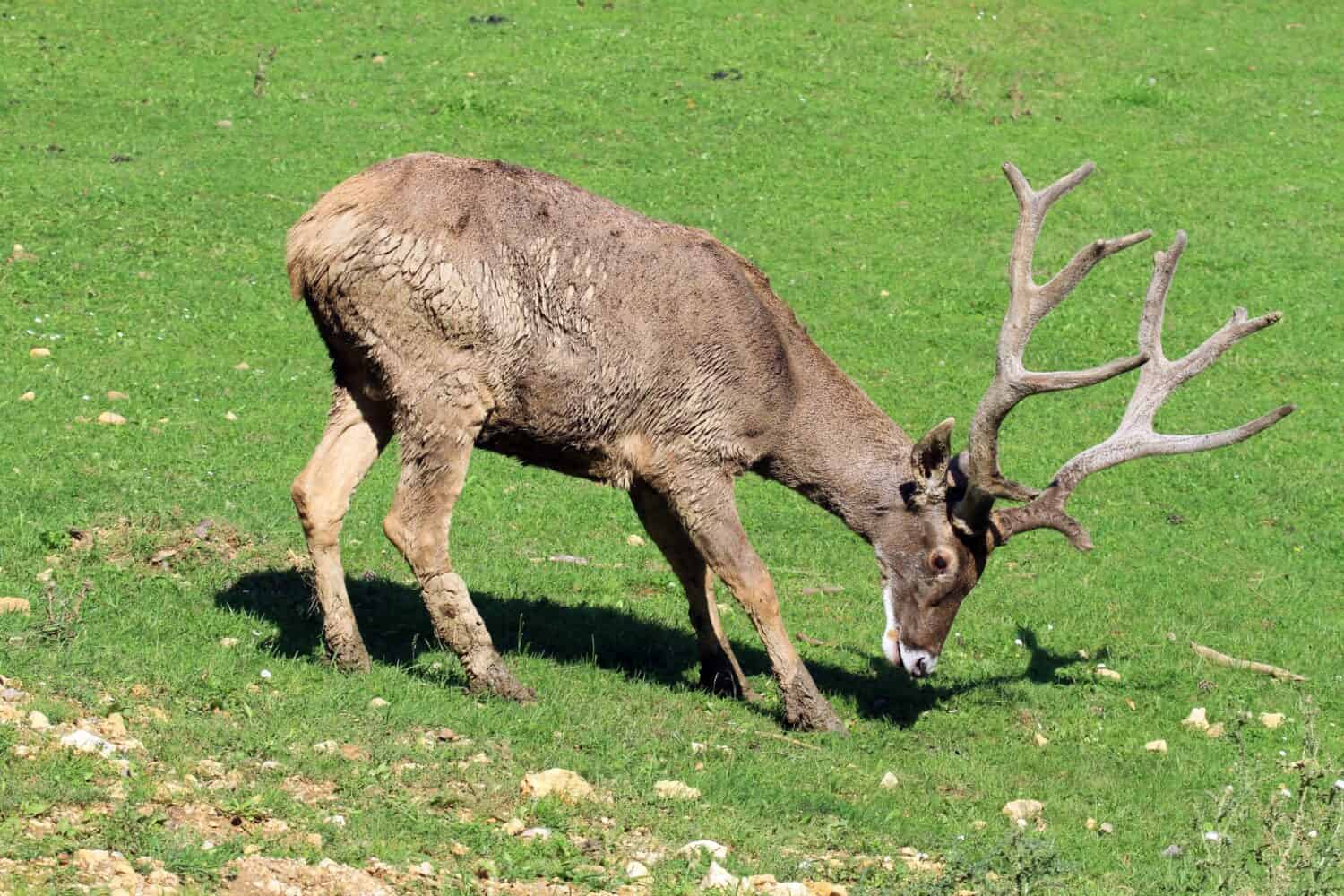
Thorold’s deer is also called the white-lipped deer because of the white markings around the mouth.
©Michal Sloviak/Shutterstock.com
Other Names: While-Lipped Deer
Range: Tibet, the Chinese provinces of Sichuan, Qinghai, Gansu, and Yunnan
Size: Thorold’s deer is about 4.5 feet high at the shoulder and they have large antlers measuring up to 43 inches long. They can grow up to 500 pounds. They are up to 6.5 feet long.
How it Compares: Thorold’s deer weigh about as much as a reindeer and as the largest white-tailed deer. Their length is similar to that of a female red deer and just slightly smaller than a white-tailed deer.
While most people are taller than a Thorold’s deer (without antlers included), this species weighs more than the majority of humans. Their large antlers are as tall as six-year-old human child.
They weigh as much as an adult grizzly bear or a small grand piano.
23. Southern Pudu
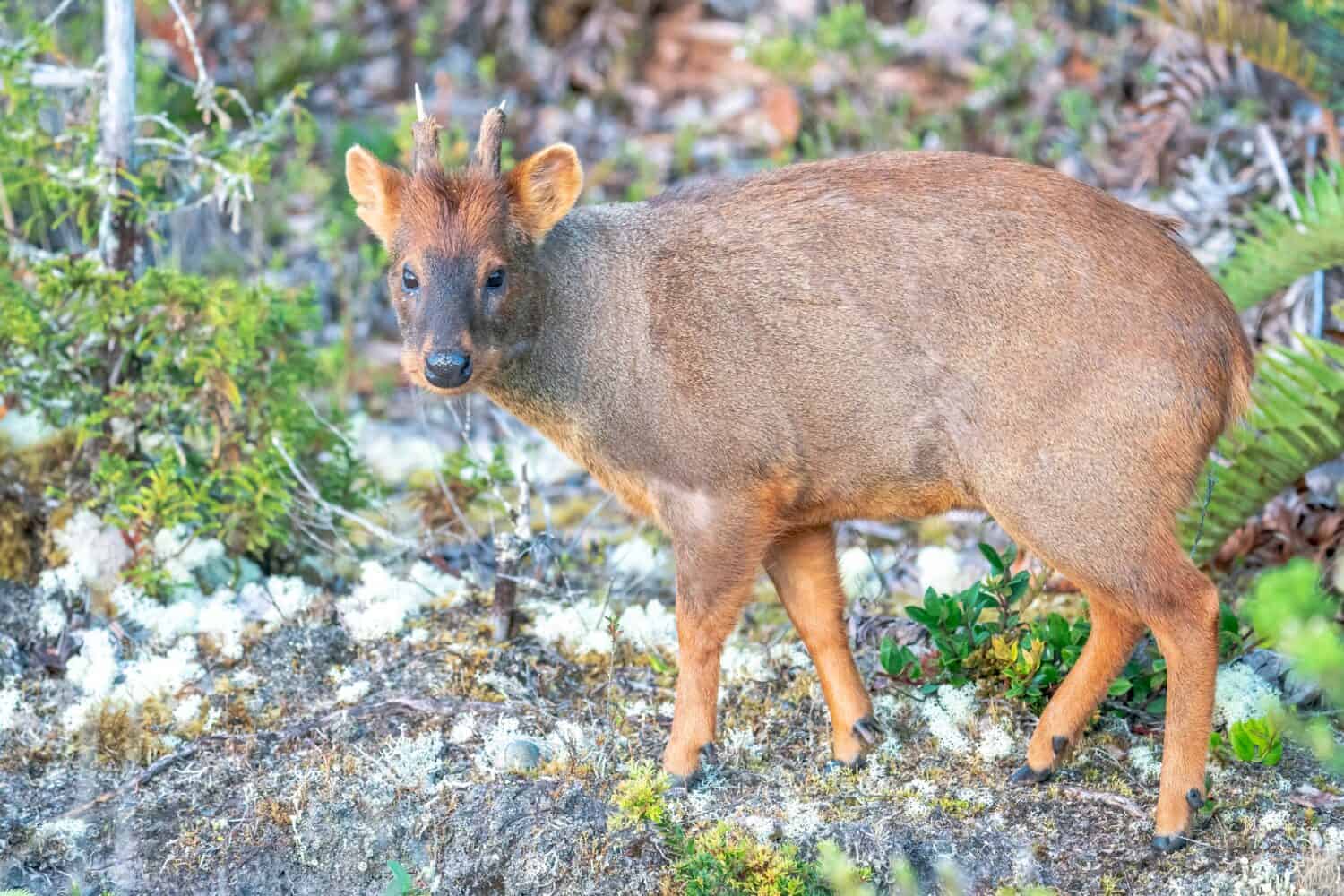
The southern pudu is the second smallest deer species.
©Rob Jansen/Shutterstock.com
Range: The Southern Andes Mountains in Chile and Argentine
Size: The southern pudu is 18 inches tall at the shoulder and can weigh as much as 30 pounds. They have antlers up to 3.5 inches long. Their body length is about 2.5 feet long.
How it Compares: This is the second smallest deer species, second only to the northern pudu. They weigh more than twice as much as their northern relatives but are still only about 2% of the weight of a moose.
They are about the height of a windshield wiper blade or a rolling pin.
Weight wise, they are the equivalent of a two-year-old human child. They are shorter than a one-year-old human, and the length of their body is similar to a three-toed sloth.
24. Javan Rusa
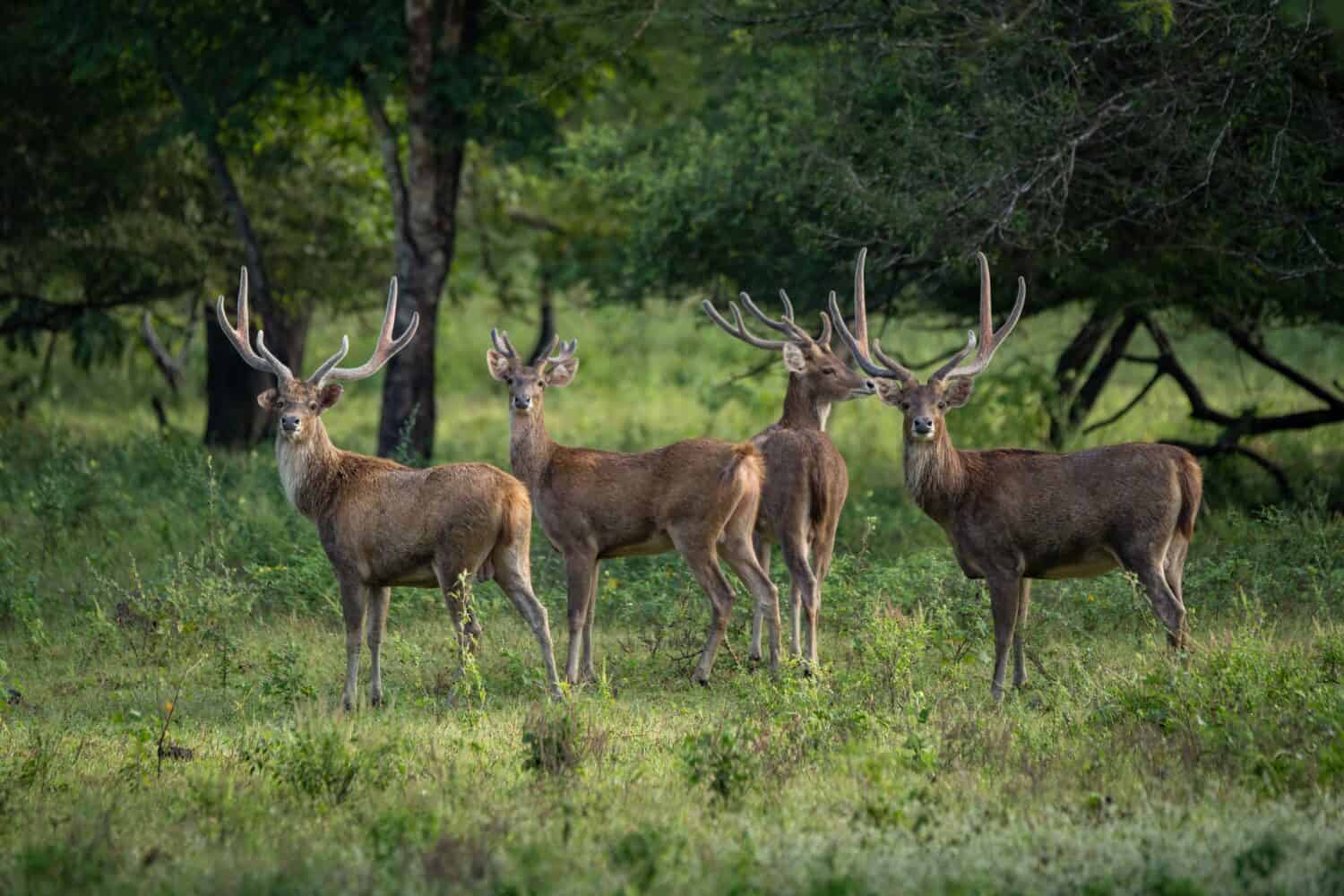
The Javan rusa grows up to 6 feet long.
©Ralfa Padantya/Shutterstock.com
Other Names: Sunda Sambar
Range: Java, Bali, and Timor
Size: This species of deer can grow up to 6 feet long. Their tails are 7.9 inches. They can weigh up to 350 pounds. Their antlers can grow to more than 3 feet long.
How it Compares: The Javan rusa is as long as moose antlers are wide. They weigh slightly more than white-tailed deer although they are slightly smaller in the other dimensions.
This type of deer is much larger than many humans in height, length, and weight. Their antlers alone are the same size as some three-year-old children.
They weigh as much as a small motorcycle, an average-sized refrigerator, or a pool table.
25. Brown Brocket

The brown brocket is a different color than the red brocket.
©Brester Irina/Shutterstock.com
Other Names: Gray Brocket
Range: South America: Peru, Argentina, Bolivia, Brazil, Paraguay, Uruguay
Size: They grow up to 3.5 feet long and weigh up to 55 pounds. They are around 2 feet high at the shoulder and their antlers are less than 5 inches long.
How it Compares: These smallish deer are about twice as large as the southern pudu. They are half the size of a Javan rusa, though they only weigh about 1/7 the amount of that species.
The Javan rusa is less than half the size of a human adult. They are more like the height of a one-year-old child but the weight of a six-year-old child.
They are about the same size as a husky breed of dog, a large microwave, or the Thompson’s gazelle.
26. Visayan Spotted Deer

The Visayan deer has antlers that are up to 10 inches in length.
©SanderMeertinsPhotography/Shutterstock.com
Other Names: Prince Alfred’s Deer, Visayan Deer, Philippine Spotted Deer
Range: The Philippines
Size: This deer species is 4.25 feet long and 2.5 feet tall. They weigh up to 175 pounds. Their antlers grow up to 10 inches long.
How it Compares: This deer species are as long as an elk’s antlers alone. They weigh just over 1/10 the weight of an elk. Their antlers are less than 1/4 the size of an elk’s as well.
The Visayan deer is about the same weight as the average human adult but is quite a bit shorter.
They weigh about as much as a grey wolf or a bighorn sheep. Their height is just less than the average kitchen counter height.
The photo featured at the top of this post is © Tristan Barrington/Shutterstock.com
Thank you for reading! Have some feedback for us? Contact the AZ Animals editorial team.







